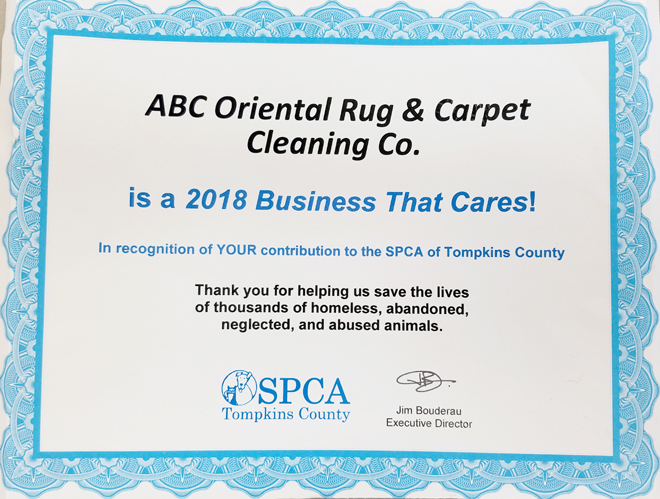ABC MONTHLY NEWSLETTER
MARCH 2020
Welcome to Our Monthly Newsletter!
We hope you will enjoy this month's articles.
This month's topics are:
ORIENTAL RUGS
TILE and GROUT
SPOT REMOVAL
MISCELLANEOUS
CONSIGNMENT RUGS FOR SALE REMINDER
If there is a topic you would like us to cover in one of our upcoming newsletters, please call us at
607-272-1566
or contact us by clicking here.
GREAT NEWS!
GOT QUESTIONS?
NOW YOU CAN TEXT US at
607-272-1566
REMINDER:
Don't forget to keep checking our website for our beautiful
You are always welcome to come in and check them out for yourself as well!
BERGAMA ORIENTAL RUGS
LOCATION
Bergama oriental rugs come from the Bergama district of the Izmir Province of northwest Turkey near the Aegean Sea. The ancient city of Bergama was one of the most powerful and richest regions in Anatolia. It was known in ancient times as Pergamon.
The history of rug weaving in the Bergama district, both hand-knotted pile rugs and flat-woven pileless kilims, dates back to approximately the 11th century.
The Bergama district includes around 80 villages and many of the villagers weave rugs. Rugs woven in 2 of the regions, Yundtag and Yagcibedir, are quite different from the rest of the Bergama rugs.
The term Bergama is actually used as a catch-all in the rug trade for the various local antique rugs from Bergama and surrounding areas. Many of the pieces called Bergama actually came from the villages of Yacgibedir, Ezine, Balekesir or Cankkale.
ANTIQUE BERGAMA ORIENTAL RUGS
Turkish rugs were held in high esteem as early as the late thirteenth century when famous traveler Marco Polo commented on them.
During the Middle Ages and the Renaissance they were dominant in the market not only in the Middle East but in Europe as well. One of the best known antique rugs attributed to the Bergama region is called the 'large pattern Holbein Rug,' since rugs of this type were painted by Hans Holbein the Younger (1497-1543) in some of his works. They consist of octagonal medallions with edges elaborated by serial pairs of curling hooks.
Other great master painters were also inspired to paint Turkish rugs as background props. Designs found in these historic carpets are inextricably associated with European painters, including Lotto, Memling, and Bellini, as well as Holbein, whose names have come to describe these iconic designs.
Antique Bergama rugs, with the special beauty of their highly traditional nature, are very sought after by rug enthusiasts. Bergama rugs offer collectors rugs that have preserved the design and color for which early Turkish rugs are so prized. The rugs are filled with powerful symbols featuring rustic tribal designs and they can fit equally well in contemporary as well as classically modern interiors.
BERGAMA ORIENTAL RUGS FROM THE 15th and 16th CENTURY--TRANSSYLVANIAN CHURCHES
These rugs are considered to have most likely been woven in Bergama by their design and structural details. Some rugs from the early 15th
century still exist and are in display in many museums around the world, including Istanbul, Berlin, and New York City. Their niche or Mihrab motif is often found as a 'double-niche.
TURKISH RUGS IN THE 15th and 16th CENTURIES
The 16th and 17th centuries saw the oriental rugs from Persia gain in popularity, overtake the Turkish rug, and attain status as the standard oriental rug.
DESIGN OF BERGAMA ORIENTAL RUGS
The designs of the Bergama village hand-knotted rugs can be divided into 2 main groups due to the influence of the different ethnic peoples who migrated to the area to join the Caucasian people already in the Bergama region:
Please continue reading here for more information and photos of Bergama Oriental Rugs.
GROUT
WHAT IS IT REALLY?
Grout? What is it really? It is the material that is applied to the spaces between tiles after the tile adhesive has fully cured during a tile installation.
The most common type of grout used to fill in the spaces between ceramic and other tile during installation is composed of graded aggregate, Portland cement, water dispersing agents, plasticizers, and color fast pigments. In more simple terms, it is the combination of cement, water, and colorant and is sometimes called cement-based or cementitious grout.
Cementitious grout comes in both premixed and powered forms. Powdered grout has to be mixed with water before use, while premixed grout comes in tubs and is convenient for small jobs.
Older cement-based grout was brittle and prone to cracking. It also dried irregularly, leaving colors inconsistent. Today's grouts contain polymer additives, which ensure color quality and increased flexibility, allowing for joint (space) widths of up to 1 1/4 inches.
WHY DO WE NEED TO USE GROUT?
Hard tile for flooring, as well as the tile in wall and countertop installation, is placed into an adhesive backing such as mortar or mastic with gaps between each tile.
This is to prevent the cracking that could occur if and when the materials expand or contract against one another during temperature shifts.
These gaps could allow moisture and germs to penetrate down into the mortar and down to the sub material.
Grout is used to seal the gaps between the tiles because it allows for the expansion and contraction of floor tile over time and prevents moisture and germ penetration.
Grout creates a floor, wall or countertop which is stronger, prevents the edges of the tiles from chipping and cracking, keeps out water, and gives the entire area a finished look with tiles that are perfectly aligned.
In certain situations such as in a shower floor construction of 1"x1" or 2"x2" mosaic tiles are used, the grout every inch or two provides a good amount of slip resistance as well.
BASIC TYPES OF GROUT
3 Basic Types of Common Grout:
- Cement Based Unsanded. Grout without sand is used when the space between tiles or stones are 1/8" wide or less.
- Cement Based Sanded. Grout with sand is used when the space between tiles or stones is greater than 1/8" wide. The sand helps bulk up the grout and keeps it from shrinking in the joints. Sanded grout can be a little more difficult to work with than non-sanded, but it is used because it is stronger and helps prevent cracking in wide joints.
- Epoxy. This type of grout contains neither cement nor water and is instead a combination of epoxy resin, silica fillers, pigments, and a hardener. It is much less porous than the cement type grouts and is used in more complicated installations or in areas where acids and greases occur (such as in a kitchen) where maximum stain resistance is needed.
Epoxy grouts also come in both sanded and unsanded forms but the type of sand is different from that found in cementitious grouts.
When using epoxy grout with porous and unglazed tiles such as limestone or quarry, the tiles should be sealed before grouting since the epoxy grout can badly stain tile surfaces such as these.
Epoxy grouts do not need to be sealed. If they do get stains, they can be scrubbed with a mixture of bleach and water or vinegar and water to clean.
OTHER NOT SO COMMON TYPES OF GROUT
Please continue reading here for more information about grout including how it is installed and information on sealers and why most grout needs to be sealed regularly.
CHEWING GUM REMOVAL
CHEWING GUM ON SHOE BOTTOMS
Chewing gum removal is something most of us have had to tackle at one time or another. We may be walking along enjoying the day and we notice a bit of stickiness underfoot.
We stop, awkwardly lift the affected foot and inspect the bottom of our shoe. Yes, there it is. A glob of chewing gum! It has attached itself and has seemed to have taken up permanent residence underfoot.
Getting a bit of gum on the bottom of a shoe may be a common occurrence and yes, it is a little gross as well, considering it spent many minutes in someone's bacteria-ridden mouth!
But the procedure for removal is easy. As you grab something to scrape it off and no doubt just go about your business, the friction of the shoe hitting the ground will eventually remove the residue.
DIY CHEWING GUM REMOVAL FROM CARPET and AREA RUGS
Chewing gum removal when the gum is warm or at room temperature, such as on a carpet or area rug, can be quite challenging. Without the special solvents professionals use, the chore could become a disaster. To do it yourself, you will need something cold to remove the gum.
Place an ice cube in a small, zip-lock bag. Rub the ice cube on the gum until it starts to harden. When it seems hard enough, break the gum off the fibers. Be careful not to force the issue, since you could physically damage the fibers.
Once you are successful in removing most of the gum, some kind of a solvent would be needed to deal with the residue. A very small amount of a dry solvent, such as rubbing alcohol, on a white cloth can help remove any residues.
DIY CHEWING GUM REMOVAL FROM CLOTHING
Please continue reading here for information o chewing gum removal from clothing.
MONTH OF MARCH DATES
The month of March brings us much to be grateful for. In many areas of the country, winter is still wreaking havoc, but the coming of March gives us the promise of Spring, regrowth, and renewal.
Here are a few special days this March 2020 with a pledge and a bit of history as well...
SPRING - MARCH 20, 2020
PLEDGE TO BE A BEE HELPER THIS SPRING
It may not seem possible, but Spring will officially arrive on March 20th this year. When we think of Spring, we think of warmer weather and growing things, like flowers.
We propose this year to also think of our bees and pledge to a Bee Helper.
Bees do much more than just make honey. Honeybees are vital to American agriculture and more than 75 percent of the world's food crops rely to some extent on pollination for yield and quality.
The absence of bees and other pollinators would wipe out coffee, apples, almonds, tomatoes and cocoa, to name just a few of the crops that rely on pollination.
According to the National Honey Board, one-third of the U.S. diet is derived from insect-pollinated plants and honey bees are responsible for 80 percent of that process.
There has been much concern about the dwindling numbers of bees. Those of us who are able can do our own part to help the bees.The good news is that there are ways you can help bee colonies in your own yard. You only need a small plot of land for a bee garden (it can even be a window container or a rooftop) to create an inviting oasis for bees. Every little bit can help to nurture bees and other pollinators.
Here are some tips for what you can do to pitch in and help them along:
- Plant bee-friendly flowers. You might even go so far as to plan an entire bee garden. Avoid hybrids and double flowers, which often have little to no pollen.
- Plant in patches, as bees like to focus on one type of flower at a time, and make sure you have flowers blooming all season.
- Spring Flowers: Crocus, Hyacinth, Borage, Calendula, and wild Lilac.
- Summer Flowers: Bee Balm, Cosmos, Echinacea, Snapdragons, Foxglove, and Hosta.
- Fall Flowers: Zinnias, Sedum, Asters, Witch Hazel, and Goldenrod (late bloomers).
- Limit or eliminate the use of pesticides. The Honeybee Conservancy recommends bringing in praying mantises and ladybugs instead, or using an organic pesticide if necessary. Spray at night when pollinators are least active. And they say to avoid chemicals belonging to the neonicotinoid family at all costs because they are especially harmful to bees.
- Fill a small dish with clean water. Then arrange pebbles and stones so they poke out. Bees will land on the stones and pause for a drink.
- Additionally, the Honeybee Conservancy recommends leaving a patch of the garden in a sunny spot uncultivated for native bees that burrow. Some native bees also need access to soil surface for nesting. For wood- and stem-nesting bees, this means piles of branches, bamboo sections, hollow reeds, or nesting blocks made out of untreated wood. Mason bees need a source of water and mud, and many kinds of bees are attracted to weedy, untended hedgerows.
- Support beekeeping efforts by buying local honey.
- Sponsor a hive via the Bee Conservancy. Click here to find out how.
*******************************************************
MARCH 17th - ST. PATRICK'S DAY
FROM LOCAL to GLOBAL in 400 YEARS
Find out how St. Patrick's Day became a global holiday as well as what special day in March has been set aside as National Vietnam War Veterans Day by clicking here.
MARCH SPECIALS
It's the THIRD Month of Our
Regular Customer Appreciation Discount (RCAD)
All Month Long...
20% Off
All Wall-to-Wall Carpet Cleaning
&
30% Off
Tile and Grout Cleaning
AND
Pay with Cash or Check
for an extra
5% Off!
PLUS
More Cleaning Specials &
Extra Savings for
YOU
and Your Family & Friends!
Please call our office at
607-272-1566
for details!
For info on RCAD,
please click here.
THANK YOU!! WE LOOK FORWARD TO CONTINUING TO SERVE YOUR TEXTILE CLEANING AND REPAIR NEEDS!
Get New Posts Right To Your Inbox!
Get our monthly newsletter, just like this one, delivered right to your inbox each day. Just sign up and we will send you the best new articles and videos as they become available.
Your email address will NEVER be spammed, sold, or shared. You are welcome to unsubscribe at any time with the link in the email.
"The Cleanest Clean You've Ever Seen."
by
ABC Oriental Rug & Carpet Cleaning Co.
130 Cecil Malone Drive Ithaca, NY 14850
607-272-1566

ABC
Carpet & Rug
Spotting Guide

ABC Oriental Rug & Carpet Cleaning Co. has been family-owned and operated in Ithaca and surrounding areas for more than 49 years.
Our company is a reflection of our family name and pride.
Please Like us on Facebook!
for more information and to find out what we are doing at our business and in the community!
Stay Connected!
Links to Our Services
Allergy Cleaning
Area Rug Cleaning
Oriental Rug Cleaning
Rug Hand & Machine Repair
Upholstered Furniture Cleaning
Tile & Grout Cleaning & Sealing
We are proud sponsors of the SPCA of Tompkins CO:

Newsletter Archives


